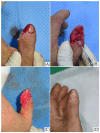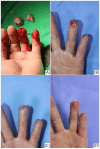Advancing Fingertip Regeneration: Outcomes from a New Conservative Treatment Protocol
- PMID: 38999212
- PMCID: PMC11242295
- DOI: 10.3390/jcm13133646
Advancing Fingertip Regeneration: Outcomes from a New Conservative Treatment Protocol
Abstract
Background Fingertip injuries with volar pulp tissue defects present a significant challenge in management. This study aimed to evaluate the efficacy of a conservative treatment protocol using artificial dermis and semi-occlusive dressings for these injuries. Methods A single-center, prospective study was conducted on 31 patients with fingertip injuries involving volar pulp defects. The treatment protocol included wound debridement, application of artificial dermis (Pelnac®), and a semi-occlusive dressing (IV3000®). The outcomes were assessed using subjective questionnaires and objective measures, including fingerprint regeneration, sensory function, pain, and cosmetic appearance. Results The mean treatment duration was 45.29 days (SD = 17.53). Complications were minimal, with only one case (3.22%) directly attributable to the treatment. Fingerprint regeneration was considerable (mean score = 2.58, SD = 0.67). The sensory disturbances were minimal, with no significant differences across injury types. Post-treatment pain was low (mean = 0.45, SD = 0.67), and cosmetic satisfaction was high (mean = 4.09, SD = 0.94). The overall patient satisfaction was high (mean = 4.41, SD = 0.67), regardless of injury severity. Conclusions The conservative treatment protocol using artificial dermis and semi-occlusive dressings is a promising strategy for managing fingertip injuries with volar pulp defects. This approach minimizes surgical morbidity and achieves excellent functional and aesthetic outcomes.
Keywords: Pelnac®; artificial dermis; fingerprint; fingertip; reconstruction; regeneration; semi-occlusive; volar.
Conflict of interest statement
The author declares no conflicts of interest.
Figures





Similar articles
-
IV3000 semi-occlusive dressing use in simple and complex fingertip injuries: efficacy and affordability.J Wound Care. 2022 Apr 2;31(4):340-347. doi: 10.12968/jowc.2022.31.4.340. J Wound Care. 2022. PMID: 35404693
-
Non-operative management of fingertip injuries with an intravenous dressing.J Wound Care. 2015 Jun;24(6):276, 278-9. doi: 10.12968/jowc.2015.24.6.276. J Wound Care. 2015. PMID: 26075376 Clinical Trial.
-
Pelnac® artificial dermis assisted by vacuum sealing drainage for treatment of severe avulsion injuries of the fingers.J Orthop Surg Res. 2025 Feb 4;20(1):136. doi: 10.1186/s13018-025-05547-z. J Orthop Surg Res. 2025. PMID: 39905439 Free PMC article.
-
Fingertip and Thumb Tip Wounds: Changing Algorithms for Sensation, Aesthetics, and Function.J Hand Surg Am. 2017 Apr;42(4):274-284. doi: 10.1016/j.jhsa.2017.01.022. J Hand Surg Am. 2017. PMID: 28372640 Review.
-
Locoregional Options for Acute Volar Pulp Fingertip Defects.Hand Clin. 2021 Feb;37(1):11-26. doi: 10.1016/j.hcl.2020.09.004. Hand Clin. 2021. PMID: 33198911 Review.
Cited by
-
Semi-occlusive dressings for the management of fingertip amputations: A systematic review.J Hand Microsurg. 2025 Mar 1;17(3):100241. doi: 10.1016/j.jham.2025.100241. eCollection 2025 May. J Hand Microsurg. 2025. PMID: 40182737 Review.
-
The Use of the Great Toe Pulp Free Flap in Dystrophic Fingertips.J Pers Med. 2025 Jan 23;15(2):44. doi: 10.3390/jpm15020044. J Pers Med. 2025. PMID: 39997321 Free PMC article.
References
-
- Karthi Sundar V., Gandhi B.S., Sundaram P.S. Surgical management of fingertip injuries. Int. J. Res. Orthop. 2017;3:19.
-
- Lin J., Wang J., Hu D., Xu Y., Zhang T. Reconstruction of Finger Pulp Defects, in Atlas of Finger Reconstruction: Techniques and Cases. Springer Nature Singapore; Singapore: 2023. pp. 225–244.
LinkOut - more resources
Full Text Sources

